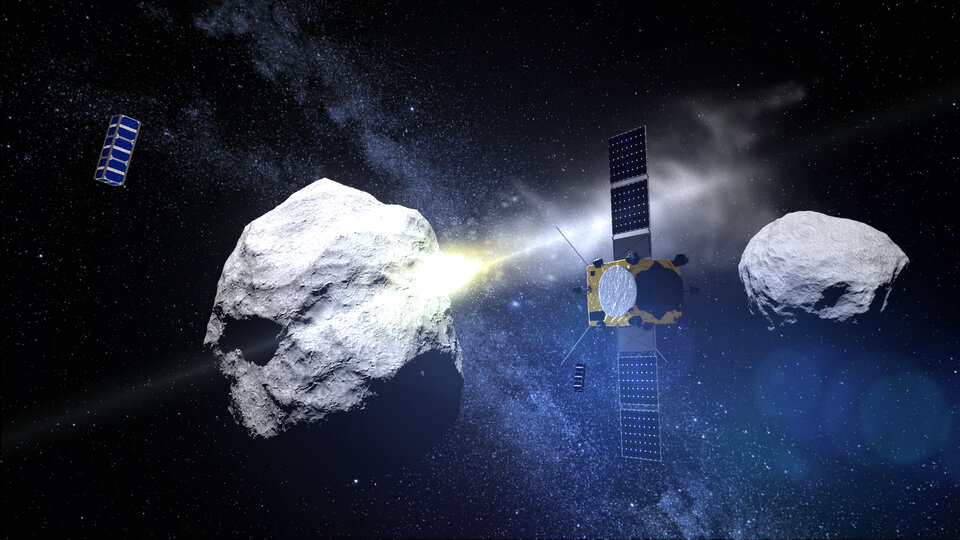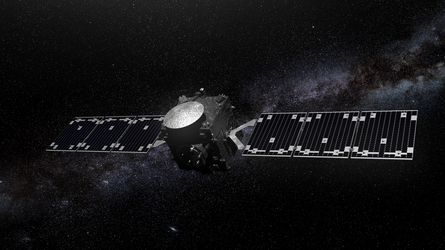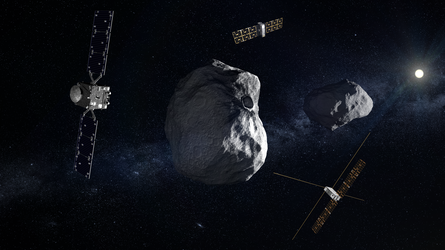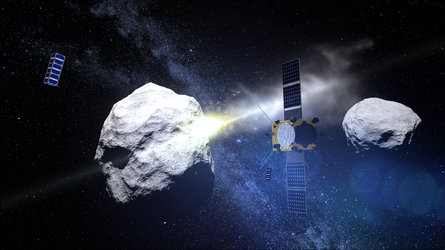Europe-wide team bringing ESA’s asteroid mission nearer to life
Companies across Europe are teaming up to tackle different aspects of ESA’s proposed Asteroid Impact Mission. Its detailed definition work has begun, ahead of a go/nogo decision next month.
The Asteroid Impact Mission, or AIM, is proposed for launch to the Didymos double asteroids in 2020 as part of the first-ever demonstration of a planetary defence method together with NASA’s Double Asteroid Redirection Test impactor spacecraft.
AIM will gather all the technical data required to validate impact models as DART strikes the smaller of the two bodies, while also deploying two CubeSats for complementary (and riskier) observations and putting down the Mascot-2 microlander on the Didymos’ tiny moon to probe its deep interior structure.
AIM is a mission in a hurry because asteroid Didymos continues its race for a 2022 close encounter with our planet. The onus is on industry to maintain the pace: since 2011 more than 40 companies across 15 ESA Member States have been shaping a highly innovative and fast mission.

“This wide array of activities now being carried out underlie how AIM is becoming more and more of a truly European project,” says Ian Carnelli, managing the mission for ESA.
“We’ve started our detailed definition work with industry, while the decision on full implementation of the mission will be taken at ESA’s Council of Ministers next month. This is a very important step to maintain our pace and test new approaches enabling faster mission implementation by integrating ESA, industry and payload teams.”
GMV in Madrid, for instance, is conducting important tests on the navigation camera provided by Germany’s Max Planck Institute. GMV is evaluating image-based navigation software for the mission by having the camera scrutinise imagery that ESA’s Rosetta comet chaser acquired during its 2010 flyby of the 100 km-diameter Lutetia asteroid, on the way to its Comet 67P/Churyumov–Gerasimenko.

“No two asteroids are exactly the same, and in fact the Didymos asteroids are actually too far distant for ground astronomers to know their precise surface characteristics,” explains Michael Kueppers, AIM project scientist.
“But these Rosetta images offer a useful analogue to try out the precision navigation we will need to manoeuvre around our target ‘Didymoon’ and ultimately release Mascot-2 towards its surface within a few centimeters per second accuracy.”
“The navigation camera in question is already flying on NASA’s Dawn mission to main-belt asteroids, and has already contributed to a wealth of new scientific discoveries.”

The team is also working with research consortiums who have put forward CubeSats to fly aboard AIM, ahead of a final selection to fly.
“It is inspiring to see the progress on the AIM design as NASA continues this innovative collaboration with ESA in the joint Asteroid Impact & Deflection Assessment,” declared Lindley Johnson, Program Executive of the Planetary Defense Coordination Office at NASA.
“Our joint concept has significant strategic benefit to both space agencies. While both missions would have substantial independent results, this collaborative endeavor will yield considerably greater benefits for international efforts on asteroid impact threat mitigation.”

AIM’s network of mothership, lander and CubeSats in deep space will be a world first, paving the way for new exploration architectures. AIM will also demonstrate novel technology, enabling the spacecraft to navigate autonomously around the asteroid as a self-driving spacecraft.
This stepping stone mission will allow future deep-space spacecraft to benefit from its wealth of technology demonstrations.
AIM’s industrial team is led by OHB (Germany) with QinetiQ Space (Belgium), GMV (Spain), Antwerp Space (Belgium), Astronika (Poland), GMV-PL (Poland), Spin.Works (Portugal), GMV-PT (Portugal) and GMV-RO (Romania).















 Germany
Germany
 Austria
Austria
 Belgium
Belgium
 Denmark
Denmark
 Spain
Spain
 Estonia
Estonia
 Finland
Finland
 France
France
 Greece
Greece
 Hungary
Hungary
 Ireland
Ireland
 Italy
Italy
 Luxembourg
Luxembourg
 Norway
Norway
 The Netherlands
The Netherlands
 Poland
Poland
 Portugal
Portugal
 Czechia
Czechia
 Romania
Romania
 United Kingdom
United Kingdom
 Slovenia
Slovenia
 Sweden
Sweden
 Switzerland
Switzerland































